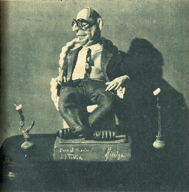 |
 |
FICHA HEMEROGRÁFICA
El maestro J. J. Tablada.
Luis Hidalgo.
Portada interna de Revista de Revistas, Año XXVI, num. 1390, 1o. de enero de 1937.
[Al pie de la escultura: "Para el maestro J. J. Tablada / Hidalgo". Esta fotografía no forma parte del Archivo Gráfico José Juan Tablada.]
NOTA
En una carta dirigida a Genaro Estrada, fechada el 5 de noviembre de 1923, José Juan Tablada, tras de quejarse de los malos tratos que recibía del cónsul Roel, describe el triunfo de Miguel Covarrubias y agrega: "Cuando los tiempos vuelvan a ser propicios, me manda Ud. a otro, Luis Hidalgo por ejemplo y en 3 meses lo hacemos triunfar aquí". Para entonces, el poeta ya había incluido un comentario elogioso sobre el artista en su artículo "Caricature that Stings", en el cual lo sitúa al lado de Olaguíbel, Covarrubias, Cabral y Salazar: "Hidalgo también es un caricaturista en la escultura. Ha revivido el arte popular de las estatuillas de cera y trapo, imprimiéndoles un vívido talento personal" (Shadowland, abril de 1923, en Obras VI, trad. Adriana Sandoval, pp. 306-310). En la crónica neoyorquina que Tablada publicó en El Universal, el 2 de agosto de 1925, da noticia de la exhibición de tres esculturas de Luis Hidalgo en el Whitney Club. El siguiente artículo, escrito en inglés por Tablada, fue publicado en Mexican Art & Life, revista que el poeta dirigió entre 1938 y 1939:
Luis Hidalgo Luis Hidalgo is a modeller in wax and waxen fabrics. Wax modelling is an old Mexican craft which has gradually ascended to the dignity of a fine art. The ancestors of Hidalgo were devotees of this art and their genius appears to have culminated in him.
After enriching the iconography of his country by creating a vast gallery of types in which he portrayed famous men, from fighters to generals, and poets to politicians, Hidalgo went years ago to New York where he applied to the portrayal of notable American men, his peculiar and incisive talent. His representations of these types of individuals are not copies but paraphrases stressing that which is characteristic of a person or the group.
Nor is he a one sided caricaturist overwhelmed by a mocking or burlesque trend. Grace and beauty as well as the grotesque flow from his carving stick with equal integrity and the denizens of the East Side provide a pungent constrast to the feminine beauty of his patrician women, as expressed, for example, in the charming arabesque of Lynn Fontanne in "Strange Interlude".
Because of this adaptable quality of feeling and expressing opposed characteristics, Hidalgo has had as subjects a large number of theatrical people. His series of "Volpone" and Walter Hampden’s "Caponssachi" are already famous. A glance will demonstrate the diversity of his models who have been recruited from the great melting pot and include types of the sidewalks of New York. Eugene O'Neil, ex-President Coolidge, Colonel Lindbergh, Katharine Cornell, Michio Ito, Dempsey, Charles Chaplin, William Beebe, Claude Bragdon and Helen Westley, have all been his subjects. It was Claude Bragdon, indeed, who wrote of Hidalgo: "Hidalgo is the artist who can transfix a moment".[Mexican Art & Life, n. 3, July 1938]
RMS